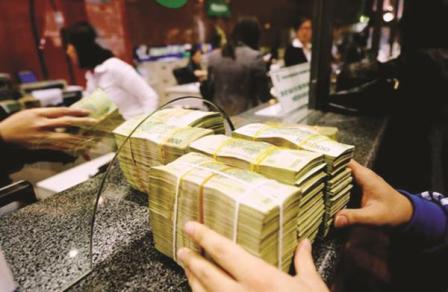
News
Banks face the pressure of raising capital
Summary
Updated on : 21-07-2017

VCN- The State Bank of Vietnam (SBV) decided to decrease the VND short-term lending rate by 0.5%, leading to the response of a series of commercial banks, which was a positive move for credit growth, contributing to economic growth. However, this problem can create a reaction to commercial banks when facing a great pressure on capital.

Great pressure
According to the assessment of banking system in the first 6 months of 2017 of the National Financial Supervision Commission, the liquidity of the banking system has been abundant since May 2017 after local signs of tensions. Loan / deposit ratio was estimated at 87% of the credit institution system, an increase of 1.53% compared to the end of 2016. The deposit growth in the first 6 months of 2017 was estimated to increase 6.1% over the end of 2016 (the same period was 10.2%). In addition, liquidity is further supported by deposits from the State Treasury at banks in the context of slow budget investment (by the end of May 2017, the deposit of the State Treasury reached 143 trillion VND, an increase of 50.2% over the beginning of 2017).
In addition, the liquidity was supported as the State Bank of Vietnam continued to increase its foreign exchange reserves, which amounted to nearly US$ 42 billion, boosting capital supply. As a result, interest rates in the interbank market not only stabilized but it also declined sharply in the second quarter. According to the Vietnam Institute for Economic and Policy Research (VEPR), average overnight rate reached 1.47% in June 2017, a decrease of 3.24 % compared to the end of last quarter; and the one-week interest rate fell to 1.84%.
Despite liquidity support, the deposit growth in 6 months of 2017 (6.1%) was still much lower than the same period of last year (10.2%). Meanwhile, credit growth has grown rapidly, an increase of nearly 8%. This has made speculators concerned about the gap between supply and demand. Therefore, according to experts, the move to adjust many types of interest rates and short-term lending rates in VND by the State Bank of Vietnam was a reasonable solution. Because if the State Bank of Vietnam adjusts the ceiling deposit rate as usual, it will cause the cash flow to other financial channels, such as gold, foreign currency and securities, causing much difficulty for raising capital and a negative situation.
Relieving
A common observation of banking system experts is that the system is suffering from too much pressure on capital and capital mobilization. Accordingly, on the other hand, the bank is raising capital to supply the economy, the region has to supply 68.1% of capital needs in 2016 and credit growth target of 18% in 2017. On the other hand, the banking system must mobilize capital to meet the rate of using short-term capital for long-term loans in accordance with Circular 06/2016 / TT-NHNN amending and supplementing some articles of Circular 36/2014 / TT-NHNN on the limits, the rate of safety in operation of credit institutions and foreign bank branches. In accordance with this circular, in 2018, this rate is reduced to 40%.
Therefore, Mr. Nguyen Duc Hung Linh, the Director of analysis and investment advisory for individual clients of Saigon Securities Inc. (SSI), said that interest rates should be kept stable because inflation and liquidity are "insecure" from now until the end of the year. Inflation at a low level in the first 6 months of the year, is expected to increase in the second half of 2017 when the peak season is over. This is the time when the food crisis has passed. If people do not return to the floor, the supply at the end of the year will decrease, causing food prices to rise again. In particular, in terms of liquidity, the banking system was well supported in the early months of the year due to the deposits of the State Treasury as well as the indirect investment flows. However, this capital flow will be difficult to keep because the Government is urging solutions to boost public investment. Therefore, interest rates should be kept stable to increase mobilized capital sources for the banking system.
In addition, in this context, some experts have continued to raise their opinions on raising USD deposit rates to 0.25% per annum. Because foreign currency demand is higher for trade deficit, banks have to borrow foreign currency at foreign banks at high interest rates, so the interest rate of USD deposits at 0% per annum will not be enough attractive for people. However, according to Mr. Nguyen Duc Hung Linh, raising interest rates in USD mobilization may return to the process of "dollarization". Although the United States raised the interest rate by 2%, the interest rate of VND deposits is currently around 6%, minus the 2% devaluation, we still have 2% difference to attract overseas remittance. According to Mr. Linh, there should be policies to attract remittances, such as remittance bonds with stable interest rates, higher interest rates, which may contribute to the increase in deposits at banks.
In addition, in order to help banks relieve the pressure on capital mobilization, experts also suggested that the State Bank of Vietnam should think of ways to mobilize gold among from the public by issuing gold certificate, as a kind of paper. Besides, banking expert Dr. Can Van Luc also proposed that the State Bank of Vietnam should adjust the timeframe to meet the Circular 06 to help banks escape the race to raise interest rates if any, which reduces costs and contributes to lowering interest rates.
By Huong Diu/ Hoang Anh
Most Recent News
| Title | Category | Created On |
|---|---|---|
| VIDEO: Ngành Hải quan thực hiện 3 nhiệm vụ quan trọng hàng đầu chuyển đổi số | News | 2024-10-01 06:06:55 |
| Vốn đầu tư trực tiếp nước ngoài giải ngân cao nhất trong 5 năm qua | News | 2024-07-16 16:06:43 |
| Thị trường Bắc Âu bổ sung 9 quy định đối với hạt điều nhập khẩu | News | 2024-06-28 14:37:14 |
| Singapore tăng thuế dịch vụ hàng hóa (GST) từ 8% lên 9% | News | 2024-05-10 16:09:44 |
| Hoa Kỳ khởi xướng điều tra chống bán phá giá đĩa giấy nhập khẩu từ Việt Nam | News | 2024-05-10 16:02:56 |
Search All News
|
A Quick Intro |
Search Trade Information
|
|
|
|
|
|
|
|
|
|
|
|
|
|
Feature Information
|
|
|
|
|
|
|
|
|
|
|
Information & Articles
|
|
|
|
|
|
|
|
|
|
|
|
Contact Us! If you cannot find what you require in this website please feel free to contact us. Click here to send us a message >>>
|